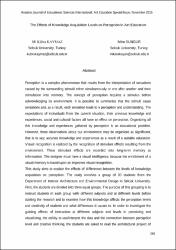| dc.contributor.author | Kaymaz, M. Kübra | |
| dc.contributor.author | Sungur, Mine | |
| dc.date.accessioned | 2020-07-10T10:54:49Z | |
| dc.date.available | 2020-07-10T10:54:49Z | |
| dc.date.issued | 2015 | en_US |
| dc.identifier.citation | Kaymaz, M. K, Sungur, M. (2015). The effects of knowledge acquisition levels on perception in art education. Anadolu Journal of Educational Sciences International (AJESI), 5 (3), 266-281. | en_US |
| dc.identifier.issn | 2146-4014 | |
| dc.identifier.uri | https://hdl.handle.net/11421/24209 | |
| dc.description.abstract | Perception is a complex phenomenon that results from the interpretation of sensations
caused by the surrounding stimuli either simultaneously or one after another and their
stimulation into memory. The concept of perception requires a stimulus before
acknowledging its environment. It is possible to summarize that the stimuli cause
sensations and, as a result, each sensation leads to a perception and understanding. The
expectations of individuals from the current situation, their previous knowledge and
experiences, social and cultural factors all have an effect on perception. Organizing all
this knowledge and experiences gathered by perception is an educational problem.
However, these observations about our environment may be organized as significant,
that is to say; accurate knowledge and experiences as a result of a suitable education.
Visual recognition is realized by the recognition of stimulant effects resulting from the
environment. These stimulant effects are recorded into long-term memory as
information. The designer must have a visual intelligence, because the enrichment of a
visual memory is based upon an improved visual recognition.
This study aims to explain the effects of differences between the levels of knowledge
acquisition on perception. The study involves a group of 30 students from the
Department of Interior Architecture and Environmental Design in Selcuk University.
First, the students are divided into three equal groups. The purpose of this grouping is to
instruct students in each group with different subjects and at different levels before
starting the research and to examine how this knowledge affects the perception levels
and creativity of students and what differences it causes to. In order to investigate the
guiding effects of instruction at different subjects and levels in perceiving and
visualizing, the ability to use/interpret the data and the connection between perception
level and creative thinking, the students are asked to read the architectural project of
Anadolu Journal of Educational Sciences International, Art Education Special Issue, November 2015
267
rectorate building of Selcuk University located in Konya province and to write down
their observations into their sketch books freely by using the techniques they know. As
a result of the study, it is determined that the differences during knowledge acquisition
also affect the perception of students in a different way. Besides the fact that planned
use of visual expression techniques led students to have a holistic approach when
perceiving, the lack of theoretical knowledge made it difficult to visualize their
perceptions and focusing on background knowledge caused to have a limited
representations in detail by the students. | en_US |
| dc.language.iso | eng | en_US |
| dc.publisher | Anadolu Üniversitesi | en_US |
| dc.rights | info:eu-repo/semantics/openAccess | en_US |
| dc.subject | Perception | en_US |
| dc.subject | Perceiving | en_US |
| dc.subject | Knowledge Acquisition | en_US |
| dc.subject | Visual Analysis | en_US |
| dc.subject | Looking-Seeing | en_US |
| dc.title | The effects of knowledge acquisition levels on perception in art education | en_US |
| dc.type | article | en_US |
| dc.relation.journal | Anadolu Journal of Educational Sciences International (AJESI) | en_US |
| dc.contributor.department | Anadolu Üniversitesi | en_US |
| dc.identifier.volume | 5 | en_US |
| dc.identifier.issue | 3 | en_US |
| dc.identifier.startpage | 266 | en_US |
| dc.identifier.endpage | 281 | en_US |
| dc.relation.publicationcategory | Makale - Ulusal Hakemli Dergi - Başka Kurum Yazarı | en_US |


















